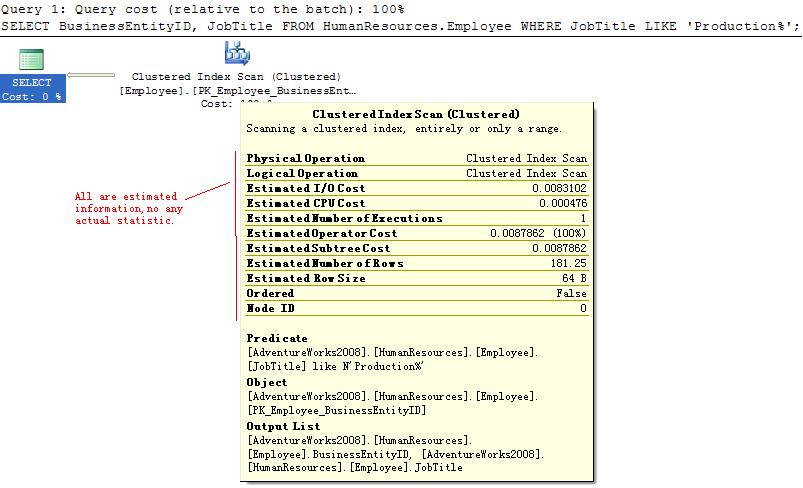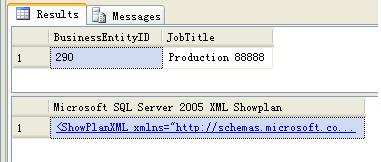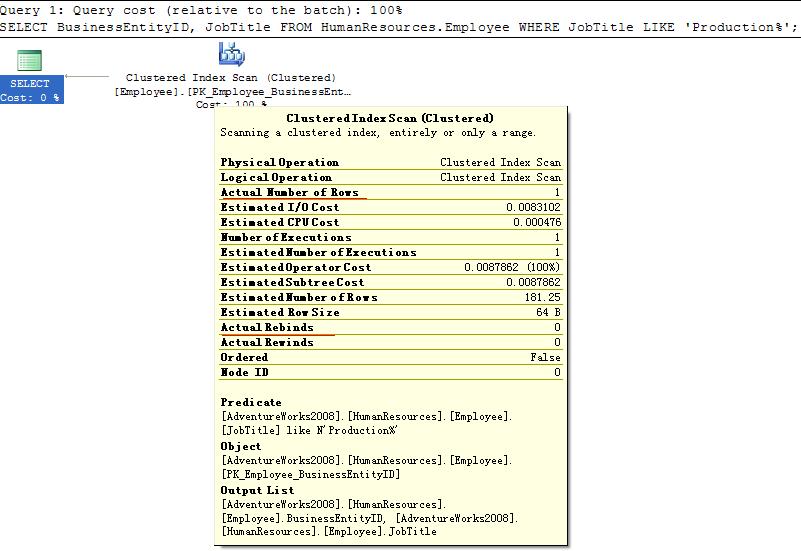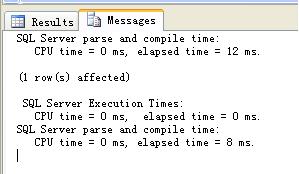SET Statements for SQLServer
SET SHOWPLAN_ALL { ON | OFF }
- It will not execute the TSQL statements.
- It cannot be specified inside a stored procedure,must be the only statements in a batch.
- Returns information as a set of rows that form a hierarchical tree representing the steps taken by the SQL Server query processor as it executes each statement. Each statement reflected in the output contains a single row with the text of the statement, followed by several rows with the details of the execution steps.
SET SHOWPLAN_ALL ON;
GO
SELECT BusinessEntityID, JobTitle
FROM HumanResources.Employee
WHERE JobTitle LIKE 'Production%';
GO
SET SHOWPLAN_ALL OFF;
GO

All the information in the resultset are estimated, no any actual statistics information.
SET SHOWPLAN_XML { ON | OFF }
- It will not execute the TSQL statements.
- It will return detailed information about how the statements are going to be executed in XML.
SET SHOWPLAN_XML ON;
GO
SELECT BusinessEntityID, JobTitle
FROM HumanResources.Employee
WHERE JobTitle LIKE 'Production%';
GO
SET SHOWPLAN_XML OFF;
GO


SET SHOWPLAN_TEXT { ON | OFF }
- It will not execute the TSQL statements.
- It cannot be specified inside a stored procedure,must be the only statements in a batch.
- Returns information as a set of rows that form a hierarchical tree representing the steps taken by the SQL Server query processor as it executes each statement. Each statement reflected in the output contains a single row with the text of the statement, followed by several rows with the details of the execution steps. The table shows the column that the output contains.
- SET SHOWPLAN_TEXT is intended to return readable output for Microsoft Win32 command prompt applications such as the osql utility. SET SHOWPLAN_ALL returns more detailed output intended to be used with programs designed to handle its output.
SET SHOWPLAN_TEXT ON;
GO
SELECT BusinessEntityID, JobTitle
FROM HumanResources.Employee
WHERE JobTitle LIKE 'Production%';
GO
SET SHOWPLAN_TEXT OFF;
GO

SET STATISTICS PROFILE { ON | OFF }
- It will execute the TSQL statements.
- Returns information as a set of rows that form a hierarchical tree representing the steps taken by the SQL Server query processor as it executes each statement. Each statement reflected in the output contains a single row with the text of the statement, followed by several rows with the details of the execution steps.
- While compare with SHOWPLAN_ALL, it has two additional column Rows,Executes.
SET statistics profile ON;
GO
SELECT BusinessEntityID, JobTitle
FROM HumanResources.Employee
WHERE JobTitle LIKE 'Production%';
GO
SET statistics profile OFF;
GO

SET STATISTICS XML { ON | OFF }
- It will execute the TSQL statements.
- It will generate detailed information about how the statements were executed in XML.
- SET STATISTICS XML need not be the only statement in a batch.
- SET STATISTICS XML returns output as nvarchar(max) for applications, such as the sqlcmd utility, where the XML output is subsequently used by other tools to display and process the query plan information. The xml comply with below xsd file \Microsoft SQL Server\100\Tools\Binn\schemas\sqlserver\2004\07\showplan\showplanxml.xsd
- SET STATISTICS PROFILE and SET STATISTICS XML are counterparts of each other. The former produces textual output; the latter produces XML output. In future versions of SQL Server, new query execution plan information will only be displayed through the SET STATISTICS XML statement, not the SET STATISTICS PROFILE statement.
- If Include Actual Execution Plan is selected in SQL Server Management Studio, this SET option does not produce XML Showplan output. Clear the Include Actual Execution Plan button before using this SET option.
SET STATISTICS XML ON;
GO
SELECT BusinessEntityID, JobTitle
FROM HumanResources.Employee
WHERE JobTitle LIKE 'Production%';
GO
SET STATISTICS XML OFF;
GO


SET STATISTICS TIME { ON | OFF }
- When SET STATISTICS TIME is ON, the time statistics for a statement are displayed. When OFF, the time statistics are not displayed.
- The setting of SET STATISTICS TIME is set at execute or run time and not at parse time.
- Microsoft SQL Server is unable to provide accurate statistics in fiber mode, which is activated when you enable the lightweight pooling configuration option.
- The cpu column in the sysprocesses table is only updated when a query executes with SET STATISTICS TIME ON. When SET STATISTICS TIME is OFF, 0 is returned.
- ON and OFF settings also affect the CPU column in the Process Info View for Current Activity in SQL Server Management Studio.
SET STATISTICS TIME ON;
GO
SELECT BusinessEntityID, JobTitle
FROM HumanResources.Employee
WHERE JobTitle LIKE 'Production%';
GO
SET STATISTICS TIME OFF;
GO

SET STATISTICS IO { ON | OFF }
- When STATISTICS IO is ON, statistical information is displayed. When OFF, the information is not displayed.
- After this option is set ON, all subsequent Transact-SQL statements return the statistical information until the option is set to OFF.
- When Transact-SQL statements retrieve LOB columns, some LOB retrieval operations might require traversing the LOB tree multiple times. This may cause SET STATISTICS IO to report higher than expected logical reads.
Output item
Meaning
Table
Name of the table.
Scan count
Number of seeks/scans started after reaching the leaf level in any direction to retrieve all the values to construct the final dataset for the output.
Scan count is 0 if the index used is a unique index or clustered index on a primary key and you are seeking for only one value. For example WHERE Primary_Key_Column = <value>.
Scant count is 1 when you are searching for one value using a non-unique clustered index which is defined on a non-primary key column. This is done to check for duplicate values for the key value that you are searching for. For example WHERE Clustered_Index_Key_Column = <value>.
Scan count is N when N is the number of different seek/scan started towards the left or right side at the leaf level after locating a key value using the index key.
logical reads
Number of pages read from the data cache.
physical reads
Number of pages read from disk.
read-ahead reads
Number of pages placed into the cache for the query.
lob logical reads
Number of text, ntext, image, or large value type (varchar(max), nvarchar(max), varbinary(max)) pages read from the data cache.
lob physical reads
Number of text, ntext, image or large value type pages read from disk.
lob read-ahead reads
Number of text, ntext, image or large value type pages placed into the cache for the query.
SET STATISTICS IO ON;
GO
SELECT BusinessEntityID, JobTitle
FROM HumanResources.Employee
WHERE JobTitle LIKE 'Production%';
GO
SET STATISTICS IO OFF;
GO

SET FORCEPLAN { ON | OFF }
- When FORCEPLAN is set to ON, the SQL Server query optimizer processes a join in the same order as the tables appear in the FROM clause of a query. In addition, setting FORCEPLAN to ON forces the use of a nested loop join unless other types of joins are required to construct a plan for the query, or they are requested with join hints or query hints.
- SET FORCEPLAN essentially overrides the logic used by the query optimizer to process a Transact-SQL SELECT statement. The data returned by the SELECT statement is the same regardless of this setting. The only difference is the way in which SQL Server processes the tables to satisfy the query.Query optimizer hints can also be used in queries to affect how SQL Server processes the SELECT statement.
USE AdventureWorks2012;
GO
-- Make sure FORCEPLAN is set to OFF.
SET SHOWPLAN_TEXT OFF;
GO
SET FORCEPLAN OFF;
GO
SET SHOWPLAN_TEXT ON;
GO
-- Example where the query plan is not forced.
SELECT p.LastName, p.FirstName, v.Name
FROM Person.Person AS p
INNER JOIN HumanResources.Employee AS e
ON e.BusinessEntityID = p.BusinessEntityID
INNER JOIN Purchasing.PurchaseOrderHeader AS poh
ON e.BusinessEntityID = poh.EmployeeID
INNER JOIN Purchasing.Vendor AS v
ON poh.VendorID = v.BusinessEntityID;
GO
-- SET FORCEPLAN to ON.
SET SHOWPLAN_TEXT OFF;
GO
SET FORCEPLAN ON;
GO
SET SHOWPLAN_TEXT ON;
GO
-- Reexecute inner join to see the effect of SET FORCEPLAN ON.
SELECT p.LastName, p.FirstName, v.Name
FROM Person.Person AS p
INNER JOIN HumanResources.Employee AS e
ON e.BusinessEntityID = p.BusinessEntityID
INNER JOIN Purchasing.PurchaseOrderHeader AS poh
ON e.BusinessEntityID = poh.EmployeeID
INNER JOIN Purchasing.Vendor AS v
ON poh.VendorID = v.BusinessEntityID;
GO
SET SHOWPLAN_TEXT OFF;
GO
SET FORCEPLAN OFF;
GO

DBCC DROPCLEANBUFFERS 清除数据缓存
DBCC FREEPROCCACHE 清除执行计划缓存
REFERENCES
SET SHOWPLAN_XML
http://technet.microsoft.com/en-us/library/ms187757.aspx
SET SHOWPLAN_TEXT
http://technet.microsoft.com/en-us/library/ms176058.aspx
SET SHOWPLAN_ALL
http://technet.microsoft.com/en-us/library/ms187735.aspx
SET STATISTICS PROFILE
http://technet.microsoft.com/en-us/library/ms188752.aspx
SET STATISTICS XML
http://technet.microsoft.com/en-us/library/ms176107.aspx
SET Statements for SQLServer的更多相关文章
- IBatis.Net项目数据库SqlServer迁移至Oracle经验
最近完成了一个(IBatis.Net+MVC)项目的数据库+代码迁移工作,可把我折腾得~~~ IBatis.Net是一个ORM框架,具体介绍可以问度娘.我之前没用ORM框架使用经验,所以这一路我不是走 ...
- SqlServer性能优化 即席查询(十三)
执行计划,查询类别: 1.即席查询 2.预定义查询 select c.EnglishProductCategoryName,p.EnglishProductName,p.Color,p.Siz ...
- 解剖SQLSERVER 第十五篇 SQLSERVER存储过程的源文本存放在哪里?(译)
解剖SQLSERVER 第十五篇 SQLSERVER存储过程的源文本存放在哪里?(译) http://improve.dk/where-does-sql-server-store-the-sourc ...
- Sql Server之旅——第十一站 简单说说sqlserver的执行计划
我们知道sql在底层的执行给我们上层人员开了一个窗口,那就是执行计划,有了执行计划之后,我们就清楚了那些烂sql是怎么执行的,这样 就可以方便的找到sql的缺陷和优化点. 一:执行计划生成过程 说到执 ...
- sqlserver的执行计划
一:执行计划生成过程 说到执行计划,首先要知道的是执行计划大概生成的过程,这样就可以做到就心中有数了,下面我画下简图: 1. 分析过程 这三个比较容易理解,首先我们要保证sql的语法不能错误,sele ...
- SQLServer DMV Query
1.DMV Query to identify all active SQL Server Sessions The query below identifies all currently acti ...
- Declare Cusror of SQLServer
Defines the attributes of a Transact-SQL server cursor, such as its scrolling behavior and the query ...
- SQLServer temporary table and table variable
Temporary tables are created in tempdb. The name "temporary" is slightly misleading, for ...
- SQL语句大全(mysql,sqlserver,oracle)
SQL语句大全 --语句功能--数据操作SELECT --从数据库表中检索数据行和列-selectINSERT --向数据库表添加新数据行-insertDELETE --从数据库表中删除数据行-del ...
随机推荐
- JAVA操作COOKIE
JAVA操作COOKIE 1.设置Cookie Cookie cookie = new Cookie("key", "value"); cookie.setMa ...
- MySQL中的datetime与timestamp比较-------转载
原文地址http://database.51cto.com/art/200905/124240.htm MySQL中的datetime与timestamp比较 本文将通过实例比较MySQL中的date ...
- github上有android开源项目
下面是一些比较好的开源项目,总共分为5大类,也许对某一些人有用,有些项目也许将来某一天对自己也有用,所以整理到此,希望对大家有帮助.首先声明非原创,这篇blog的目的是分享给那些可能需要的人. htt ...
- POJ 2528 Mayor's posters(线段树区间染色+离散化或倒序更新)
Mayor's posters Time Limit: 1000MS Memory Limit: 65536K Total Submissions: 59239 Accepted: 17157 ...
- [ZZ] RGBM and RGBE encoding for HDR
Deferred lighting separate lighting rendering and make lighting a completely image-space technique. ...
- js 创建书签小工具之理论
我们一直在寻找增加浏览体验的方法,有的方法众所周知,有的则鲜为人知.我原本认为书签小工具属于后者,非常令人讨厌的东西.令我非常懊恼的是我发现在这个问题上我完全是错误的.它并不是令人厌烦的,而是以用户为 ...
- Ecshop、Discuz! 等开源产品的局限
Ecshop.Discuz! 等开源产品的局限 记得今年年初,我初次接触Discuz!和Ecshop时,一阵阵地惊叹:成熟度这么高的产品,居然是免费的.我们这些搞传统软件开发的要怎么活?另外也奇怪,做 ...
- DirectX 基础学习系列6 字体
DIRECTX9自带ID3DXFONT类 内部调用GDI的接口,效率一般,但能够处理一些复杂的字体 HRESULT D3DXCreateFontIndirect( LPDIRECT3DDEVICE9 ...
- wordpress 添加自定义菜单到管理面板(wp-admin)
如果你在做 wordpress 主题或插件的开发,通常需要在后台dashboard管理面板添加菜单方便用户做主题设置或插件设置.这篇文章要讨论的问题就是怎么样加这个菜单,加在哪里? 添加顶级菜单项 a ...
- PHP文件操作 之读取目录信息
//定义一个函数 读取目录信息的函数 function dirInfo($dirName) { //判断目录是否存在 if (!file_exists($dirName)) { die('目录不存在! ...
